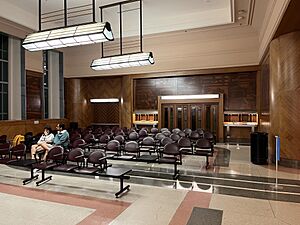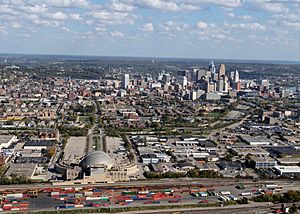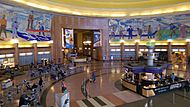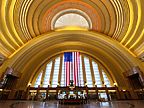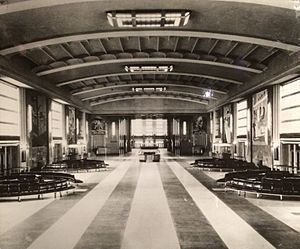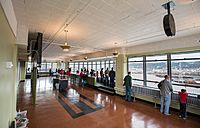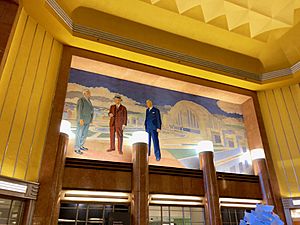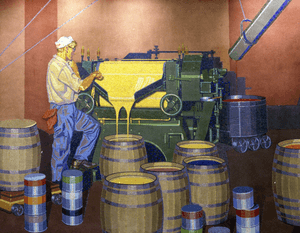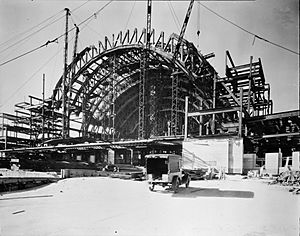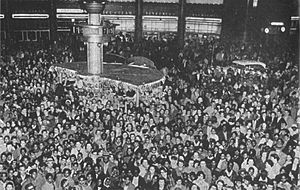Cincinnati Union Terminal facts for kids
Quick facts for kids
Cincinnati Union Terminal
|
|||||||||||
|---|---|---|---|---|---|---|---|---|---|---|---|
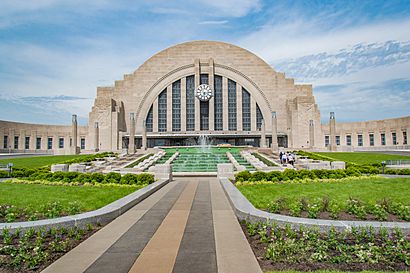
The main entrance of the terminal.
|
|||||||||||
| Location | 1301 Western Avenue Cincinnati, Ohio |
||||||||||
| Owned by | City of Cincinnati | ||||||||||
| Line(s) | CSX Cincinnati Terminal Subdivision | ||||||||||
| Platforms | 1 side platform (originally 8) | ||||||||||
| Tracks | 2 (originally 16) | ||||||||||
| Connections | |||||||||||
| Other information | |||||||||||
| Station code | Amtrak: CIN | ||||||||||
| History | |||||||||||
| Opened | March 19, 1933 | ||||||||||
| Closed | October 29, 1972; reopened July 29, 1991 | ||||||||||
| Traffic | |||||||||||
| Passengers (FY2019) | 8,641 (Amtrak) | ||||||||||
| Services | |||||||||||
|
|||||||||||
|
|||||||||||
| Area | 287 acres (116 ha) | ||||||||||
| Built | 1928–1933 | ||||||||||
| Restored | 2016–2018 | ||||||||||
| Architect | Fellheimer & Wagner | ||||||||||
| Architectural style(s) | Art Deco | ||||||||||
| Visitors | 1.8 million (in 2019) | ||||||||||
| Website | Amtrak station listing | ||||||||||
| Designated | May 5, 1977 | ||||||||||
| Reference no. | 72001018 | ||||||||||
| Designated | October 31, 1972 | ||||||||||
| Reference no. | 72001018 | ||||||||||
|
Invalid designation
|
|||||||||||
| Designated | March 6, 1974 | ||||||||||
| Reference no. | 0079-1974 | ||||||||||
Cincinnati Union Terminal is a famous train station and museum center in Cincinnati, Ohio. People often call it CUT or by its Amtrak station code, CIN. The terminal is a stop for Amtrak's Cardinal train, which passes through three times a week.
Today, the building's main use is as the Cincinnati Museum Center. This center includes the Cincinnati History Museum, the Museum of Natural History & Science, the Duke Energy Children's Museum, and an Omnimax theater.
The terminal is famous for its unique Art Deco architecture and amazing artwork. Inside the main hall, called the Rotunda, there are two huge mosaic murals. These murals, created by artist Winold Reiss, show scenes from Cincinnati's history. The building is so important that it has been named a National Historic Landmark.
The station was built between 1928 and 1933. It was created to be a "union station," which means it brought together seven different railroad companies into one single terminal. During World War II, the station was very busy. But after the war, fewer people traveled by train. Train service stopped completely in 1972.
The building was mostly empty until 1990, when it reopened as the Cincinnati Museum Center. In 1991, Amtrak trains returned, and it became a train station once again. A major renovation project was completed in 2018 to preserve this historic building for the future.
What's Inside Union Terminal?
The City of Cincinnati owns the building, but the train tracks belong to the freight railroad company CSX Transportation. The city leases the building to Amtrak and the Cincinnati Museum Center.
The Museum Center is a collection of five attractions:
- Cincinnati History Museum
- Museum of Natural History & Science
- Robert D. Lindner Family Omnimax Theater
- Cincinnati History Library and Archives
- Duke Energy Children's Museum
The terminal also has the Nancy & David Wolf Holocaust & Humanity Center, several places to eat, and rooms for special events.
Train and Bus Services
The station is served by Amtrak's Cardinal train, which runs three times a week between Chicago and New York City. The trains arrive and depart very late at night or early in the morning.
Because of the late schedule, not many people use the train service here compared to other stations in Ohio.
The terminal also connects to the Metro bus system. This makes it easy to travel between the museum center and other parts of Cincinnati.
Architecture and Design
The station was designed by the architectural firm Fellheimer & Wagner. A young architect in the firm named Roland A. Wank created the modern Art Deco design. This style was chosen because it was cheerful, colorful, and less expensive than older styles like Gothic.
The building is shaped like a "T" with a giant half-dome on top. The main entrance faces east, toward downtown Cincinnati. When you walk in, you enter a huge, open space called the Rotunda. From there, a wide hall once led to the train platforms. This design was very efficient for moving thousands of passengers.
The Famous Rotunda
The most impressive part of the terminal is the Rotunda. It is a semi-circular room that is 176 feet wide and 106 feet tall. The dome is covered in sound-absorbing plaster painted in bright yellow and orange bands. The walls are covered with beautiful red and yellow marble.
The Rotunda has the largest semi-dome in the Western Hemisphere. It was the largest in the world until the Sydney Opera House was built in 1973.
A fun feature of the Rotunda is its "whispering gallery." Because of the curved shape of the dome, a person standing at one end of the arch can whisper and be heard clearly by someone standing at the other end, about 100 feet away!
The Train Concourse
Behind the Rotunda was the train concourse, a long hall that stretched over the tracks. This is where passengers waited for their trains. The concourse was decorated with 16 murals showing Cincinnati's industries. It also had a huge map of the world on one wall.
Sadly, the train concourse was torn down in 1974 to make more room for freight trains. Before it was demolished, 14 of the industrial murals were saved. The large world map mural, however, was destroyed.
Tower A Signal Control
Tower A was the nerve center of the station. From this room, workers controlled all the train switches and signals in the rail yard. It had a giant machine with 187 levers, which was the largest of its kind at the time.
The Cincinnati Railroad Club used to have a museum in this space. Today, the museum center opens Tower A to the public on special occasions.
Art of the Terminal
Union Terminal is famous for its art, especially the mosaic murals created by Winold Reiss. He was a German-American artist who designed all the murals for the Rotunda, the concourse, and other areas.
Rotunda Murals
The two largest murals are in the Rotunda. Each one is 105 feet long and 22 feet high. The mural on the south wall shows the history of the United States, from Native Americans to the industrial age.
The mural on the north wall tells the story of Cincinnati. It shows the city's growth from a small fort to a major center for industry and shipping on the Ohio River. Reiss used local construction workers and even his own family members as models for the people in the murals.
Industrial Murals
Reiss also created 16 smaller murals for the train concourse. Each one showed a different Cincinnati industry, like piano making, meat packing, and printing.
When the concourse was torn down, people worked to save these murals. Today, you can see them in two different locations. Nine of the murals are at the Duke Energy Convention Center downtown. Five others are at the Cincinnati/Northern Kentucky International Airport.
History of the Terminal
In the early 1900s, Cincinnati had five different train stations. They were old, small, and often flooded by the Ohio River. City leaders and railroad companies agreed that Cincinnati needed one large, modern station.
Building a Grand Station
The Union Terminal Company was formed in 1927 to build the new station. Construction started in 1928. It was a huge project that cost $41.5 million. The terminal officially opened on March 31, 1933.
The station opened during the Great Depression, so not many people used it at first. But during World War II, the terminal became very busy with soldiers and supplies moving across the country.
Decline and New Life
After the war, more people started traveling by car and airplane. By the 1960s, very few trains were stopping at Union Terminal. In 1972, Amtrak moved its service to a smaller station, and Union Terminal closed.
For years, the building was empty. In 1974, the long train concourse was demolished. People in Cincinnati worried that the entire building would be torn down. They formed groups to "Save the Terminal."
Their efforts paid off. In the 1980s, a shopping mall called "Oz" opened inside, but it did not last long. Finally, in 1986, local voters approved funding to turn the terminal into a museum.
The Museum Center Era
The Cincinnati Museum Center opened in 1990. It brought new life to the historic building. In 1991, Amtrak trains returned to the terminal.
In 2016, the terminal closed for a two-year, $228 million renovation. The project repaired the building's structure, cleaned the murals, and updated the museum spaces. The newly restored Cincinnati Union Terminal reopened in November 2018.
Today, it stands as a beautiful example of Art Deco design and a beloved Cincinnati landmark.
Images for kids
See also
 In Spanish: Cincinnati Union Terminal para niños
In Spanish: Cincinnati Union Terminal para niños



